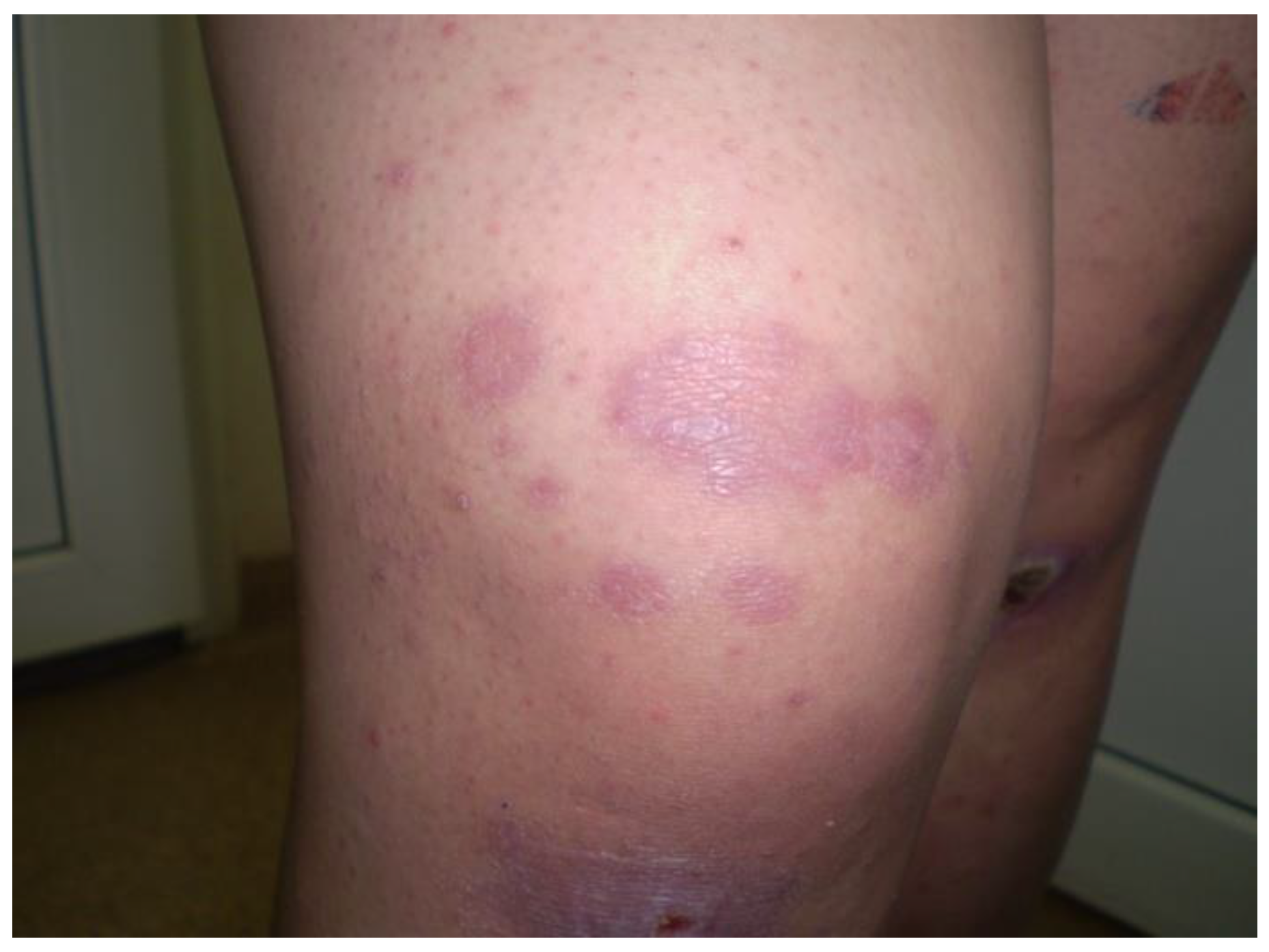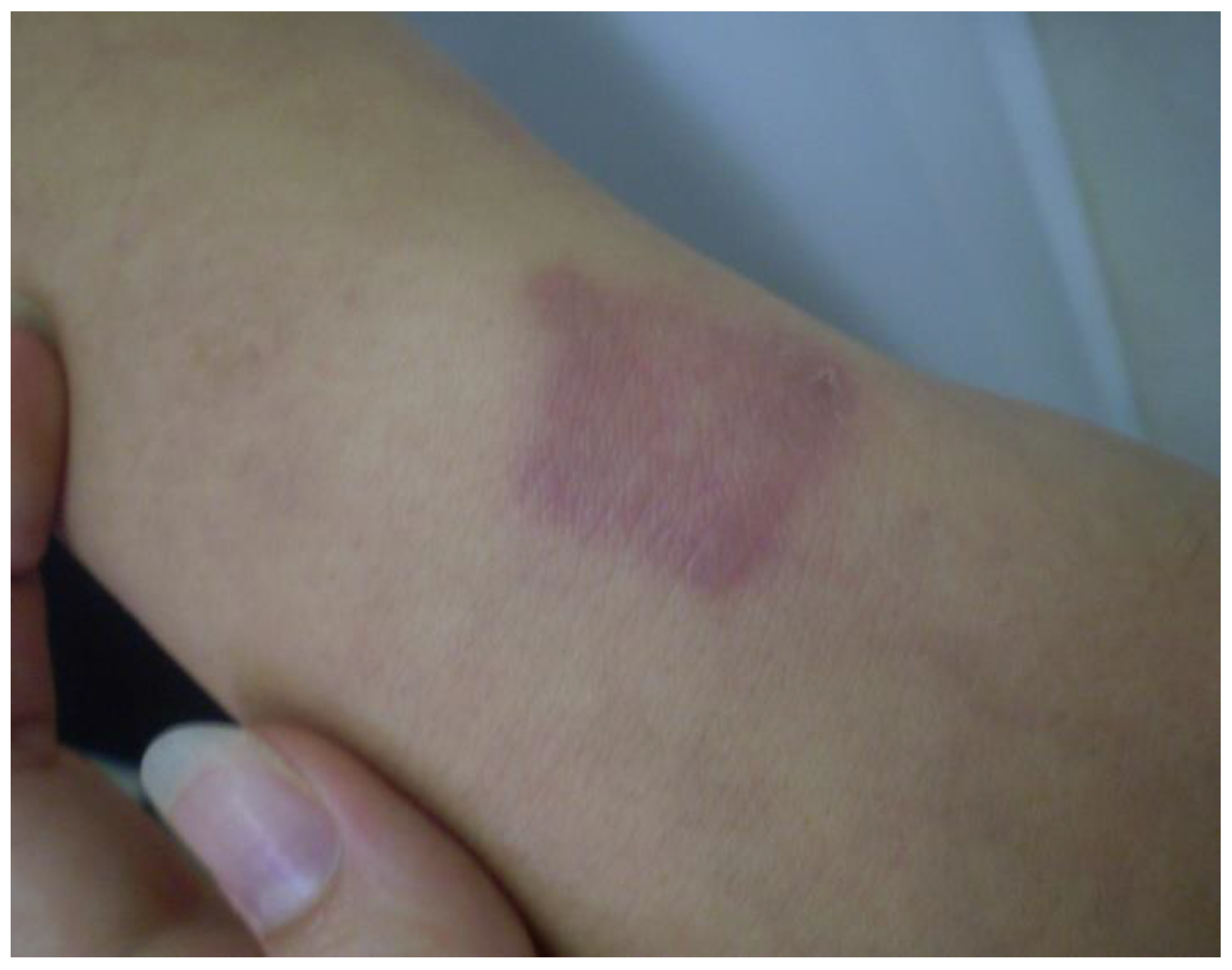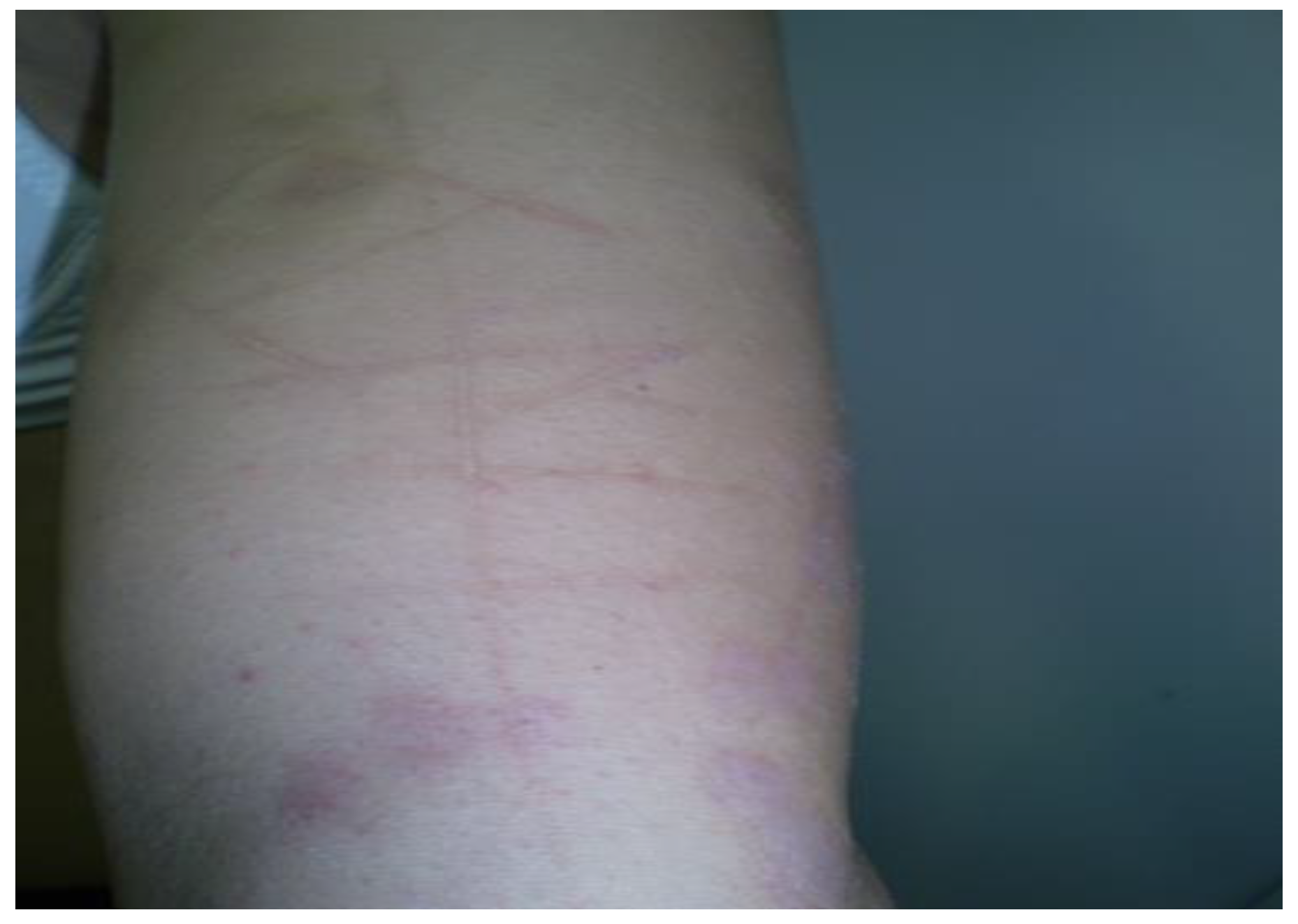Pathological Skin Picking: Case Presentation and Review of the Literature
Abstract
Introduction
Case Report
Discussion
References
- Goldsmith, L.A.; Katz, S.I.; Gilchrest, B.A.; Paller, A.S.; Leffell, D.J.; Wolff, K. Fitzpatrick’s Dermatology in General Medicine, 8th Ed. ed; McGrawHill: New York,NY, USA, 2012; ISBN 978-0071669047. [Google Scholar]
- Luca, M.; Vecchio, C.; Luca, A.; Calandra, C. Haloperidol augmentation of fluvoxamine in skin picking disorder: a case report. J Med Case Rep 2012, 6, 219. [Google Scholar] [CrossRef] [PubMed]
- Gupta, M.A.; Gupta, A.K.; Habeman, H.F. Neurotic Excoriations: A Review and Some. New Perspectives Comprehensive Psychiatry 1986, 27, 381–366. [Google Scholar] [CrossRef] [PubMed]
- Bolognia Jean, L.; Jorizzo, J.L.; Schaffer, J.V. Dermatology, 3 Ed. ed; Elsevier, 2012; ISBN 978-0-7234-3571-6. [Google Scholar]
- Gieler, U.; Consoli, S.G.; Tomás-Aragones, L.; Linder, D.M.; Jemec, G.B.; Poot, F.; Szepietowski, J.C.; de Korte, J.; Taube, K.M.; Lvov, A.; Consoli, S.M. Self-inflicted lesions in dermatology: terminology and classification--a position paper from the European Society for Dermatology and Psychiatry. Acta Derm Venereol 2013, 93, 4–12. [Google Scholar] [CrossRef] [PubMed]
- Harth, W.; Taube, K.M.; Gieler, U. Facticious disorders in dermatology. J Dtsch Dermatol Ges. 2010, 8, 361–372. [Google Scholar] [CrossRef]
- Kim, D.I.; Garrison, R.C.; Thompson, G. A near fatal case of pathological skin picking. Am J Case Rep. 2013, 14, 284–287. [Google Scholar]
- Lochner, C.; Grant, J.E.; Odlaug, B.L.; Stein, D.J. DSM-5 field survey: skin picking disorder. Ann Clin Psychiatry 2012, 24, 300–304. [Google Scholar]
- Grant, J.E.; Phillips, K.A. Captive of the mirror: I pick at my face all day, every day. Curr Psych. 2003, 2, 45–52. [Google Scholar]
- Grant, J.E.; Menard, W.; Phillips, K.A. Pathological skin picking in individuals with body dysmorphic disorder. Gen Hosp Psychiatry 2006, 28, 487–493. [Google Scholar] [CrossRef]
- Dykens, E.M.; Lee, E.; Roof, E. Prader–Willi syndrome and autism spectrum disorders: an evolving story. J Neurodev Disord. 2011, 3, 225–237. [Google Scholar] [CrossRef]
- Tareen, R.S.; Greydanus, D.E.; Jafferany, M.; Patel, D.R.; Merrick, J. Pediatric Psychodermatology: A Clinical Manual of Child and Adolescent Psychocutaneous Disorders; pg 246 Publisher: De Gruyter, Walter, Inc.; ISBN 9783110273878.
- Aboujaoude, E.; Koran, L.M. Impulse Control. (February 8, 2010), 1 ed.Cambridge University Press; p. 129. ISBN 0521898706.
- Spiegel, D.R.; Finklea, L. The Recognition and Treatment of Pathological Skin Picking Psychiatry (Edgmont). 2009; 6, 38–42. [Google Scholar] [PubMed Central]
- Grant, J.E.; Odlaug, B.L.; Chamberlain, S.R.; Keuthen, N.J.; Lochner, C.; Stein, D.J. Skin Picking Disorder. Am J Psychiatry 2012, 169, 1143–1149. [Google Scholar] [CrossRef]
- Deckersbach, T.; Wilhelm, S.; Keuthen, N. Self-Injurious Skin Picking: Clinical Characteristics, Assessment Methods, and Treatment Modalities. Brief Treatment and Crisis Intervention Oxford University Press. 2003, 3, 249–260. [Google Scholar] [CrossRef][Green Version]
- Jafferany, M. Psychodermatology: A Guide to Understanding Common Psychocutaneous Disorders. Prim Care Companion J Clin Psychiatry 2007, 9, 203–213. [Google Scholar] [CrossRef]
- Cyr, P.R.; Dreher, G.K. Neurotic excoriations. Am Fam Physician 2001, 64, 1981–1984. [Google Scholar]
- Wong, J.W.; Nguyen, T.V.; Koo, J.Y. Primary Psychiatric Conditions: Dermatitis Artefacta, Trichotillomania and Neurotic Excoriations. Indian J Dermatol. 2013, 58, 44–48. [Google Scholar] [CrossRef] [PubMed]
- Keuthen, N.J.; Wilhelm, S.; Deckersbach, T.; Engelhard, I.M.; Forker, A.E.; Baer, L.; Jenike, M.A. The Skin Picking Scale: scale construction and psychometric analyses. J Psychosom Res. 2001, 50, 337–41. [Google Scholar] [CrossRef]
- Keuthen, N.J.; Deckersbach, T.; Wilhelm, S.; Engelhard, I.; Forker, A.; O’Sullivan, R.L.; Jenike, M.A.; Baer, L. The Skin Picking Impact Scale (SPIS): scale development and psychometric analyses. Psychosomatics 2001, 42, 397–403. [Google Scholar] [CrossRef]
- Anetakis Poulos, G.M.D.; Alghothani, L.B.S.; Bendo, S.; Zirwas, M.J. Neurotic Excoriations A Diagnosis of Exclusion. J Clin Aesthet Dermatol. 2012, 5, 63–64. [Google Scholar] [PubMed]
- Simeon, D.; Stein, D.J.; Gross, S.; Islam, N.; Schmeidler, J.; Hollander, E. A double-blind trial of fluoxetine in pathologic skin picking. J Clin Psychiatry 1997, 58, 341–347. [Google Scholar] [CrossRef]
- Sharma, R.C.; Sharma, N.L. Effectiveness of fluoxetine in the treatment of skin-picking. Indian J Psychiatry 2005, 47, 241–242. [Google Scholar] [CrossRef]
- Grant, J.E.; Odlaug, B.L.; Chamberlain, S.R.; Kim, S.W. A Double-Blind, Placebo-Controlled Trial of Lamotrigine for Pathologic Skin Picking: Treatment Efficacy and Neurocognitive Predictors of Response. J Clin Psychopharmacol. 2010, 30, 396–403. [Google Scholar] [CrossRef]
- Grant, J.E.; Odlaug, B.L.; Kim, S.W. Lamotrigine treatment of pathologic skin picking: an open-label study. J Clin Psychiatry 2007, 68, 1384–1391. [Google Scholar] [CrossRef] [PubMed]
- Jafferany, M.; Shireen, F.; Ibrahim, A. An Open-Label Trial of Topiramate in the Treatment of Skin Picking in Pervasive Developmental Disorder Not Otherwise Specified. Prim Care Companion. J Clin Psychiatry 2010, 12, PCC.09l00829. [Google Scholar]
- Flessner, C.A.; Mouton-Odum, S.; Stocker, A.J.; Keuthen, N.J. StopPicking.com: Internet-based treatment for self-injurious skin picking. Dermatol Online J. 2007, 13, 3. [Google Scholar] [CrossRef]
- Twohig, M.P.; Woods, D.W. Habit reversal as a treatment for chronic skin picking in typically developing adult male siblings. J Appl Behav Anal. 2001, 34, 217–220. [Google Scholar] [CrossRef] [PubMed]




© 2015 by the author. 2015 Maria Isabela Sarbu1, Mircea Tampa, Diana Leahu, Cristina Raileanu, Vasile Benea, Simona Roxana Georgescu
Share and Cite
Sarbu, M.I.; Tampa, M.; Leahu, D.; Raileanu, C.; Benea, V.; Georgescu, S.R. Pathological Skin Picking: Case Presentation and Review of the Literature. J. Mind Med. Sci. 2015, 2, 78-88. https://doi.org/10.22543/2392-7674.1014
Sarbu MI, Tampa M, Leahu D, Raileanu C, Benea V, Georgescu SR. Pathological Skin Picking: Case Presentation and Review of the Literature. Journal of Mind and Medical Sciences. 2015; 2(1):78-88. https://doi.org/10.22543/2392-7674.1014
Chicago/Turabian StyleSarbu, Maria Isabela, Mircea Tampa, Diana Leahu, Cristina Raileanu, Vasile Benea, and Simona Roxana Georgescu. 2015. "Pathological Skin Picking: Case Presentation and Review of the Literature" Journal of Mind and Medical Sciences 2, no. 1: 78-88. https://doi.org/10.22543/2392-7674.1014
APA StyleSarbu, M. I., Tampa, M., Leahu, D., Raileanu, C., Benea, V., & Georgescu, S. R. (2015). Pathological Skin Picking: Case Presentation and Review of the Literature. Journal of Mind and Medical Sciences, 2(1), 78-88. https://doi.org/10.22543/2392-7674.1014


